Science Fiction-like Achievements: A Remarkable Era for Spinal Cord Injury Victims
- 06.09.2024
- Uncategorized

“We have created a wireless interface between the brain and the spinal cord using brain-computer interface technology that transforms thought into action,” the study’s co-lead author Grégoire Courtine,
Scientists and neurosurgeons have implanted electronic devices into the brain and spinal cord of a paralyzed man that communicate wirelessly, enhancing his ability to walk and enabling him to climb stairs, according to a study published in Nature.
To walk, the brain sends executive commands to the neurons in the lumbosacral spinal cord. While most spinal cord injuries do not directly harm these neurons, injuries disrupt the descending pathways that transmit brain signals essential for walking. As a result, this interruption leads to permanent paralysis.
The Story of Oskam
In 2011, Gert-Jan Oskam lost his ability to walk due to a spinal injury sustained in a cycling accident in China. However, six years later, the Dutch man was able to take a few short steps with the help of a small array of electrodes implanted on his spinal cord. These electrodes delivered nerve-stimulating pulses of electricity, enabling him to walk.
The BSI system consists of two fully implantable components designed to record cortical activity and stimulate the lumbosacral spinal cord in real time. It features a 64-channel electrode grid encased in a 50 mm diameter titanium shell, matching the thickness of the skull, to capture electrocorticographic (ECoG) signals from the brain.
These signals are processed to interpret the user’s motor intentions, which are then transformed into commands that stimulate leg muscles. An implantable pulse generator, connected to a 16-electrode paddle lead, delivers the electrical stimulation to the specific area. The entire system operates wirelessly, enabling the user to move freely.
“What we have been able to do is re-establish the communication between the brain and the region of the spinal cord controlling movement, using a digital bridge,” the study’s co-lead author Grégoire Courtine,
John Ruffolo from Toronto took a keen interest in how the field of spinal cord treatment is progressing as part of his own recovery from severe injuries. Read more on his story here
An avid cyclist, Ruffolo, 57, was riding his bike on a sunny day in September 2020. He was heading down a rural road about 50 km north of the city when he heard the screeching air brakes of a tractor-trailer coming up on his rear wheel.
Recovering from an injury, especially a spinal cord injury, can be a lengthy and challenging process. Rehabilitation might span months or even years as you work to regain strength and independence. Ensuring you fully utilize available resources, including government-funded programs (like OHIP) and private insurance benefits, is crucial for covering costs and possibly providing income replacement during your recovery.
Recognizing Spinal Cord Injury Symptoms
Spinal cord injuries can result from various incidents, such as car accidents or falls, leading to symptoms like numbness or weakness below the injury site, difficulty breathing, or unusual pain in the back, arms, or legs. Immediate medical attention is essential if you experience these symptoms. Diagnosis will typically involve X-rays, CT scans, and MRI scans.
Understanding Your Diagnosis
The spinal cord acts as a crucial pathway between your brain and nerves. A comprehensive assessment is needed to diagnose the extent of your injury. Treatment options may include medications, surgeries, physical and occupational therapy, and, depending on your needs, psychological counseling.
The International Standards for the Neurological Classification of Spinal Cord Injuries (ISNCSCI) categorizes the severity of spinal cord injuries from Class A (complete loss of mobility and sensation) to Class E (normal function). Injuries may be described as complete or incomplete, with incomplete injuries retaining some sensation below the level of injury.
Navigating Your Recovery
Rehabilitation plays a critical role in recovery. Depending on your injury's severity, an in-patient therapy program might be recommended to help you regain strength and adapt to mobility changes. Physical therapy can sometimes assist in relearning to walk or improving movement control. Regular sessions and check-ups with your doctor will likely continue for at least a year. It’s important to explore all funding options, potentially with legal assistance, to ensure you receive the best possible care.
Advocating For You During Your Most Difficult Time.
Boland Romaine Spinal Cord Injury lawyers have decades of experience handling cases like yours. We know that a spinal cord injury can profoundly impact every facet of a person’s life and their family's as well.
Beyond the physical pain, surgeries, and daily living challenges, the financial burden can be overwhelming. The costs for medical treatment, rehabilitation, and ongoing care can easily reach into the millions. It is essential to partner with a team of lawyers who have extensive experience in securing both legal and medical assistance for those affected by such severe injuries.
Read more on our spinal cord injury expertise here
We believe in doing your research when it comes to choosing a lawyer. Not all lawyers are made the same, and unfortunately this makes the search for one even harder. We suggest you look at their trial experience.
We explain our philosophy more on our homepage. Read more here




